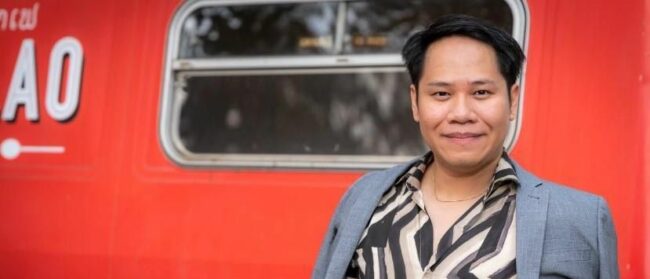As the sun arcs high above the sacred mountain citadel of Oudong, the white-robed women who call the Vipassana Dhura Meditation Centre home are preparing a midday meal for the monks. In Cambodia’s wet season, the shanty town of wooden huts lining the shaded alleyways strung between the compound’s gilded halls hosts more than 400 daun chi, lay women whose close-cropped hair and crisp white robes declare their dedication to a life of service, prayer and meditation. Today, there are just half that number.
Withered beyond her 73 years, Eang Oeurn has nowhere left to go. In 1976, a year after the fall of Phnom Penh to the ultra-Maoist Khmer Rouge, her daughter was taken by the cadres to fight as a child soldier. Ten long years later, after Oeurn had given her up for dead, her daughter sent out a call asking her family to reunite in Anlong Veng, where the last remnants of the Khmer Rouge were waging a bloody guerrilla war against the Vietnam-backed government. For more than a decade, her family worked the land given to them by the notorious ‘Butcher’ Ta Mok until the final collapse of the regime in the dying days of the 20th century.
“After the war I felt empty,” Oeurn said, her eyes hidden behind black wraparound sunglasses. “My husband was killed, some of my close family were killed, and it left me with six children to support. Now they’re grown up, and they have their own families. So I came here.”
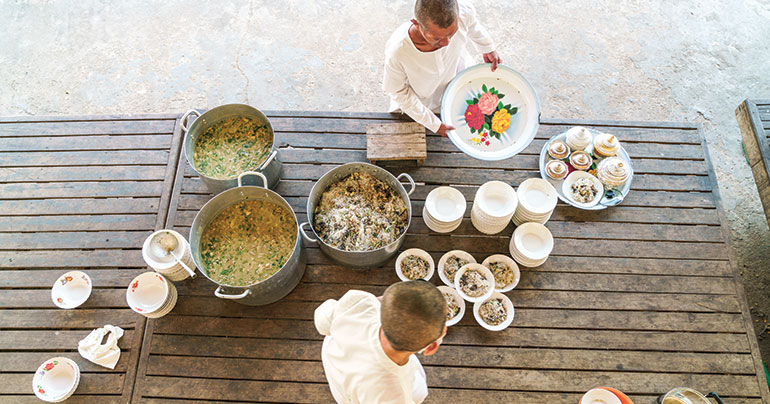
As the daun chi carry their laden trays into the dining hall, a gaggle of young boys flits between their feet, white cloth bags slung over their bony shoulders. Although their vestments may resemble those of the ageing women, their spiritual lives are just beginning: once their command of the ancient Pali tongue is more advanced, they shall join the ranks of the saffron-clad monks now streaming into the hall to be served. For the handful of young women who come to the centre in search of a religious vocation, though, the habit of a fully ordained monk in the Theravada tradition – and the respect that it commands – remains frustratingly out of reach.
“It’s more accessible to boys,” Oeurn said. “Women come here usually around 20, 30 years old – some of those come here because of a broken heart. And others are serious about the dharma and meditation, so they come and learn.”
Long a centre for learning and education in even the most remote Cambodian communities, pagodas or wats continue to attract young men and boys looking to expand their knowledge and, for some, pursue a life-long vocation as one of the sacred monks – or bhikkhu – that still comprise much of the nation’s spiritual and intellectual elite. But Buddhism scholar John Amos Marston, who co-edited History, Buddhism and New Religious Movements in Cambodia, said for most girls contemplating a life of learning and prayer, the same opportunities simply do not exist.
“I think there is nothing really parallel to this for young women,” he told Southeast Asia Globe. “Public education eliminates part of the logic for boys and young men becoming novices or bhikkhu. But there are still some boys and young men who in some sense complete their education by going to the wat. So the boys are socialised in different ways than the girls – and this does sometimes have advantages to them.”
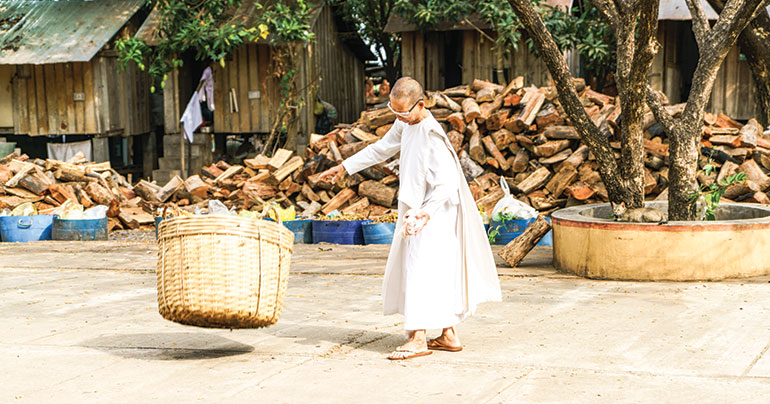
Preah Sihanouk Raja Buddhist University vice-rector Khy Sovanratana, who said he was generally supportive of the idea of female ordination, told Southeast Asia Globe that many Cambodian families did not place the same importance on girls’ education as they did on the education of their sons.
“It has long been accepted in the family that boys should receive more education than girls,” he said. “And there have been efforts and changing minds among some families that women should also receive more education. But in terms of ordination, it’s still a far way off – the families themselves aren’t really demanding that their children become female novices or fully ordained monks. I don’t see any kind of push from their families.”
A former vendor who now teaches Vipassana meditation at the centre said that the life of a lay devotee was largely seen not as a pathway to power and knowledge but as a last resort for women forced from the outside world by age, illness or tragedy.
“We need young people to carry on these teachings,” she said. “Now we get some young ladies, but the problem is they’re not all coming to learn about the Buddhist religion – some of them have mental disorders and some have been in traffic accidents. They’re hopeless, so we start to teach them the meaning of life and how to be calm and present. When they have a calm mind, all the bad spirits go away.”
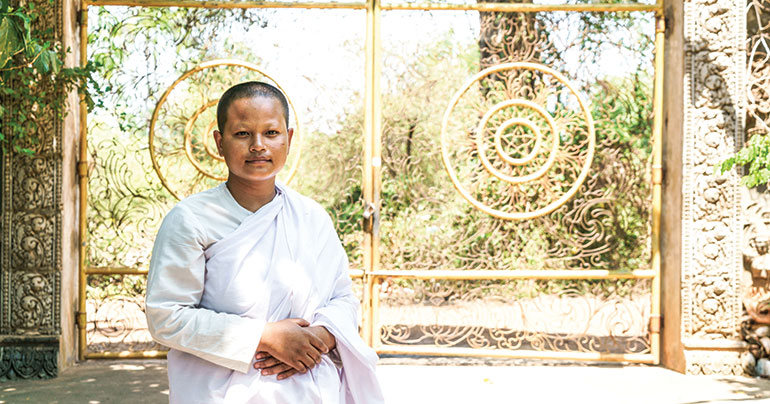
Marston said that while places such as Vipassana Dhura were placing more and more importance on education for the women who reside there, many wats across Cambodia – the majority of which lack the support of the wealthy businesspeople who sustain the Oudong centre’s development – continued to treat daun chi more as caretakers than clergy.
“There are growing numbers of wats where daun chi are given special training in Buddhism and meditation,” he said. “But it gets complicated, because some women use their residence at a wat as a kind of retirement plan. In at least some wats, they are seen more as servants of the monks.”
As someone who made no bones about her own pragmatic reasons for taking the white robe of the daun chi, Oeurn was blunt in her appraisal of the type of women her vocation attracted.
“I don’t see any young women becoming daun chi here – only old ladies who can’t work,” she said. “They don’t have anything to survive on, so they come here to seek refuge and get food and learn the dharma.”
For at least one daun chi at Vipassana Dhura, though, the simple life of a daun chi called her for a different reason. Having struggled to live by the five holy precepts followed by observant Buddhist laypeople throughout her young life, Dim Soriya put on the white robe at the age of 20 to help her follow the teachings of the Buddha. Three years later, as she watches her younger brothers take their first steps on the path to ordination, she continues to be frustrated by her inability to join them.
“I’m interested in becoming a monk, but there’s no law in Buddhism for female monks as before,” she said. “When the Buddha was alive there were female monks, but now there are only men. For me, I am really tempted to be a monk.”
As the spiritual leaders of the community, the words and actions of Cambodia’s monks continue to carry immense weight in the Buddhist kingdom – a respect that Soriya said was never given to the white-robed women who serve them.
“The level of respect is totally different. Monks have always been considered as very superior and very noble,” she said. “Monks are a ten, and we’re a two. The only difference between normal people and us is that we practice more discipline and wear white. That’s all that makes us different.”
Even when the Buddha was alive, his blood aunt had to beg him to become a female monk. And he refused so many times
While monks are forbidden to cook or handle money, relying on their daily alms rounds and the kindness of strangers to furnish them with all they need, daun chi are left to carry out the bulk of the labour at wats, interspersing their lessons – if they have them – with the rote chores of cooking, cleaning and providing sustenance both for themselves and the monks.
“Monks have time, the whole day, to fully carry out and practise the rules and disciplines, because they don’t do anything else – they don’t do the chores and housework,” Soriya said.
Chand Sirimanne, a researcher at the University of Sydney’s department of studies in religion, said that female devotees enjoyed few of the same privileges afforded to their male superiors.
“They have very few rights and no support system – for example, if you’re a fully ordained monk or a nun, there’s a temple that looks after you and a whole lay community who feeds you and provides you with all your needs,” she said.
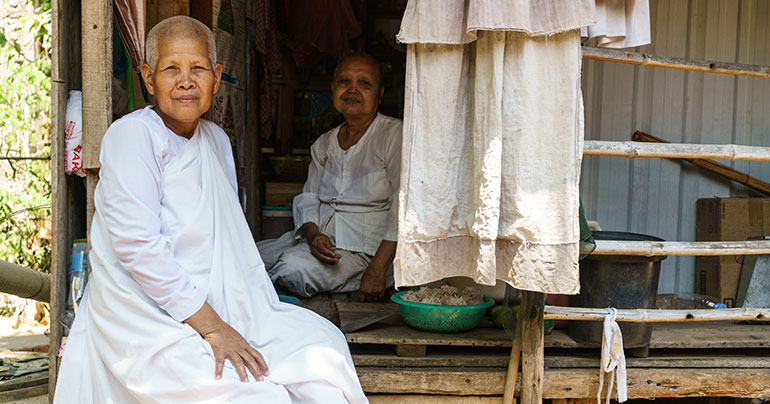
Although female monastic orders existed in the Theravada tradition for centuries after the death of the Buddha, the line was severed in the 11th century in Sri Lanka amid widespread famine and war. Even before that, women hoping to be ordained were tasked with dozens more strictures than their male counterparts, including pledges of subservience to even the lowest bhikkhu. For centuries, many pious Buddhist women have been told that their best hope of a holy life was to build up enough karma through good deeds to be reborn as a man after their death.
Phann Ratana, a 51-year-old daun chi who left behind the life of a garment worker to find peace in the teachings of the Buddha, said that the reason women could no longer be ordained as monks is that there were no longer any female monks to ordain them.
“There won’t be any rebirth – it’s impossible,” she said. “Nobody will be able to do it – even when the Buddha was alive, his blood aunt had to beg him to become a female monk. And he refused so many times. Even after she became a monk, there were many, many strict rules to being a female monk. I don’t think it’s something which will come back.”
While female ordination movements are gaining momentum in other Theravada countries such as neighbouring Thailand, the organised push for a bhikkhuni restoration in Cambodia seems to have stalled with the dissolution of internationally funded NGOs such as the Association for Nuns and Laywomen. Neither would Sri Lanka’s solution, which involved bringing Mahayana bhikkhuni from Taiwan in the late ’90s to resurrect the ordination of local women, be welcomed with open arms by Cambodia’s conservative monastic community, or sangha.
“I personally think that empowering the daun chi as daun chi can be almost as effective as creating an order of bhikkhuni,” Marston said. “Of course, individual women have to decide for themselves how important it is to actually become bhikkhuni. What’s important is that women who have a spiritual vocation find a respected way of pursuing that vocation.”
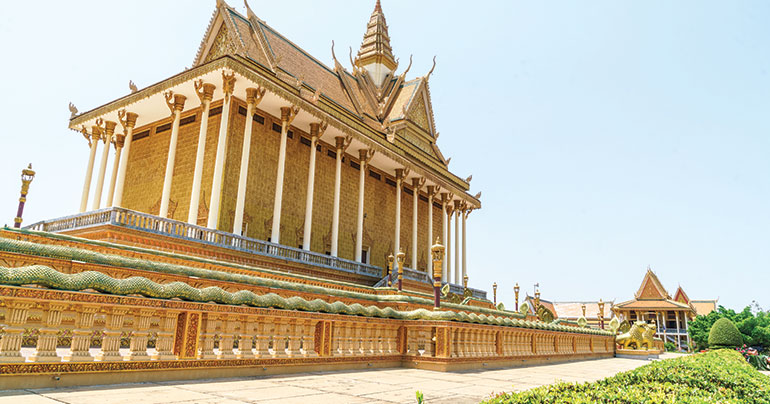
Sovanratana argued that it was up to the Kingdom’s Buddhist leaders – and the ruling Cambodian People’s Party – to judge whether the time was right to let women once again into the fold.
“There’s still a long way to go until there’s any consensus among the sangha leaders here and also from the state as well,” he said. “It rests upon all of us, especially the Theravada leaders, to see which [option] is more appropriate and try to encourage and support the admission of women into the bhikkhuni sangha if they think that it is for the benefit of Buddhism – and for the benefit of humanity. And it’s not about Buddhism or about the Buddha’s teaching – that was a long time ago. It rests upon the present Theravada leaders.”
For Soriya, though, the obstacles to her lifelong dream of devoting her body and soul to the Buddha seem almost insurmountable.
“Some people say that if we [women] can’t live by those rules, it could be bad for our image – it could destroy the whole religion,” she said. “[The supreme patriarch of Cambodia] once stated that we cannot allow having female monks, otherwise they’re going to degrade the religion. It’s impossible. I have no hope.”
Additional reporting by Leng Len


